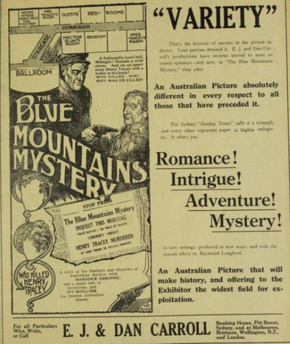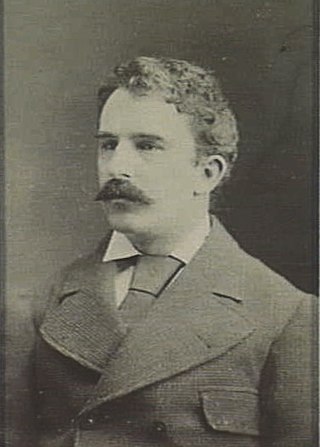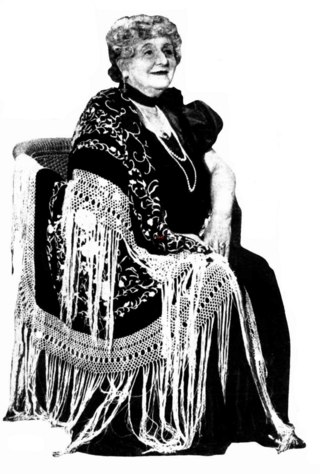Related Research Articles

John F. Gavin was a pioneer Australian film actor and director, one of the early filmmakers of the 1910s. He is best known for making films about bushrangers such as Captain Thunderbolt, Captain Moonlite, Ben Hall and Frank Gardiner. Known informally as 'Jack', Gavin worked in collaboration with his wife Agnes, who scripted many of his films.

The Blue Mountains Mystery is a lost 1921 Australian silent film directed by Raymond Longford and co-directed by Lottie Lyell.

Robbery Under Arms is a 1920 Australian film directed by Kenneth Brampton and financed by mining magnate Pearson Tewksbury. It is an early example of the "Meat pie Western".

Alfred Dampier was an English-born actor-manager and playwright, active in Australia.

Maud Evelyn Craven Jeffries was an American actress. A popular subject for a wide range of theatrical post-cards and studio photographs, she was noted for her height, voice, presence, graceful figure, attractive features, expressive eyes, and beautiful face.
Two Minutes Silence is a 1933 Australian melodrama set during World War I based on Les Haylen's anti-war play. It was the fourth and last feature film by the Sydney-based McDonagh sisters, Paulette, Isobel and Phyllis, who called it "by far the best picture we produced". It is considered Australia's first anti-war movie and is a lost film.
The Glenrowan Affair is a 1951 movie about Ned Kelly from director Rupert Kathner. It was Kathner's final film and stars VFL star Bob Chitty as Kelly. It is considered one of the worst films ever made in Australia.

Trooper O'Brien is a 1928 Australian silent film from the team of John and Agnes Gavin. It was a melodrama set during the "Ned Kelly era" about an orphaned girl raised by a policeman in the bush. It is one of the rare early Australian films that still exist in its entirety.

The Romantic Story of Margaret Catchpole, generally referred to as Margaret Catchpole, is a 1911 Australian silent film directed by Raymond Longford and starring Lottie Lyell. It is based on the true story of Margaret Catchpole, an adventurer and convict.

Alfred Rolfe, real name Alfred Roker, was an Australian stage and film director and actor, best known for being the son-in-law of the celebrated actor-manager Alfred Dampier, with whom he appeared frequently on stage, and for his prolific output as a director during Australia's silent era, including Captain Midnight, the Bush King (1911), Captain Starlight, or Gentleman of the Road (1911) and The Hero of the Dardanelles (1915). Only one of his films as director survives today.
Robbery Under Arms is a 1907 Australian silent western/drama film based on the 1888 novel by Rolf Boldrewood about two brothers and their relationship with the bushranger Captain Starlight. It was the first film version of the novel and the third Australian feature ever made.

Captain Midnight, the Bush King is a 1911 Australian silent Western film about the fictitious bushranger Captain Midnight. It was the directorial debut of actor Alfred Rolfe. The film is based on the play of same name by W. J. Lincoln and Alfred Dampier. Captain Midnight, the Bush King is now considered lost.
The Life of Rufus Dawes is a 1911 Australian silent film based on Alfred Dampier's stage adaptation of the 1874 novel For the Term of His Natural Life produced by Charles Cozens Spencer.

The Loyal Rebel is a 1915 Australian silent film directed by Alfred Rolfe set against the background of the Eureka Rebellion.

Dan Morgan is a 1911 Australian film from Charles Cozens Spencer about the bushranger Daniel Morgan. It was said to be starring "Alfred Rolfe and company". Rolfe directed three movies for Spencer, all starring himself and his wife Lily Dampier so there is a chance he may have directed this one and that it starred his wife. A prospectus for the Australian Photo Play Company said he directed it. It is considered a lost film.
His Only Chance is a 1918 Australian silent film directed by Dick Shortland. It is a high society melodrama. As with Cupid Camouflaged, the film was made to aid fund raising for the Red Cross.
Ernest Henry Higgins was an Australian cinematographer during the days of silent film. He was the eldest brother of Arthur and Tasman Higgins. He shot the film The Throwback (1920) for director Arthur Shirley which resulted in Shirley unsuccessfully suing Higgins for breach of contract.

Katherine Annabel Lily Dampier, known as Lily Dampier, was an Australian actress of stage and screen. She was the daughter of Alfred Dampier and married to Alfred Rolfe.

Ethel Knight Kelly was a Canadian–Australian actress, writer, and social leader. She appeared in a number of plays and wrote four books.

Zara Baar Aronson was a Sydney-based journalist, editor, welfare worker, feminist and restaurateur of Jewish background. She was born in Australia but spent her formative years in Europe, before returning to Sydney where she became a socialite as well as a social columnist and journalist in a number of major newspapers across Australian cities. She pursued social and charity work as well as her own business in publishing, food and catering. Aronson helped form the Society for Women Writers and a local branch of John O'London's Literary Circle, and was a founding member and secretary of the National Council of Women of Australia. During World War II she raised funds for the Junior Red Cross by selling a cookery book, after which she published another well-received cookbook, Twentieth Century Cookery Practice. In later life she was made a civil officer of the Order of the British Empire for her services to the community.
References
- ↑ "FROM NEAR AND FAR". The Sydney Morning Herald . National Library of Australia. 8 May 1918. p. 7. Retrieved 28 March 2012.
- ↑ Vagg, S., & Reynaud, D. (2016). Alfred Rolfe: Forgotten pioneer Australian film director. Studies in Australasian Cinema, 10(2),184-198. doi:10.1080/17503175.2016.1170950
- ↑ Andrew Pike and Ross Cooper, Australian Film 1900–1977: A Guide to Feature Film Production, Melbourne: Oxford University Press, 1998, p 80
- ↑ Mrs T.H. Kelly and Mr. J.B.N. Osborne, The Sydney Mail, (Wednesday 29 May 1918), p.15.
- ↑ Osborne and Kelly at the centre of still from movie at
- ↑ Osborne at left of a still from movie at .
- ↑ "SOCIAL". The Sydney Morning Herald . National Library of Australia. 13 April 1918. p. 7. Retrieved 28 March 2012.
- ↑ "FARMER-HORDERN WAR BONDS". The Sydney Morning Herald . National Library of Australia. 17 April 1918. p. 12. Retrieved 28 March 2012.
- ↑ "FROM NEAR AND FAR". The Sydney Morning Herald . National Library of Australia. 1 May 1918. p. 7. Retrieved 28 March 2012.
- ↑ ""CUPID CAMOUFLAGED."". The Sydney Morning Herald . National Library of Australia. 22 November 1919. p. 15. Retrieved 28 March 2012.
- ↑ "At the Movies". The Mirror . Sydney: National Library of Australia. 7 June 1918. p. 11. Retrieved 10 November 2014.
- ↑ "CUPID CAMOUFLAGED". The Sydney Morning Herald . National Library of Australia. 1 June 1918. p. 14. Retrieved 19 November 2014.
- ↑ "CUPID CAMOUFLAGED". The Sunday Times . Sydney: National Library of Australia. 2 June 1918. p. 9. Retrieved 19 November 2014.
- ↑ "Australian Notes", Moving Picture World 6 Jul 1918 – 31 Aug 1918 p. 1128